
By Brendon Harre*
New Zealand’s housing crisis has been described as a Gordian knot.
A problem tangled with too many vested interests.
A problem that requires a cataclysmic solution.
An Alexander the Great to break the knot with one mighty sword blow.
I believe that such a revolutionary response is unnecessary, and that gradual reform is possible.
I believe understanding and synthesizing the strands of the urbanisation debate can give insights into how urban performance can be improved.
Understanding the different strands of the urbanisation debate allows a framework to be created that can gradually unravel New Zealand’s urban performance gordian knot.
The first strand of the debate to understand is spatial economics
Supply and demand for houses
This can be summarised by the following diagrams.
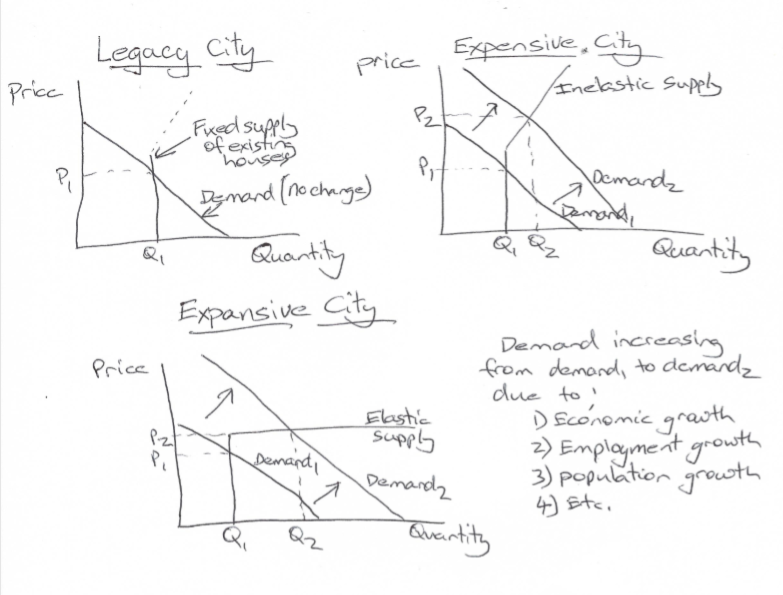
It is important to understand that demand for the various types of urban spaces -housing and commercial spaces, car parking spaces, street spaces, and so on, is increasing strongly in Auckland, New Zealand’s largest city.
This is due to strong population, economic and employment growth.
Increasing demand for residential space means Auckland is not a legacy city -such as an Invercargill or a Detroit.
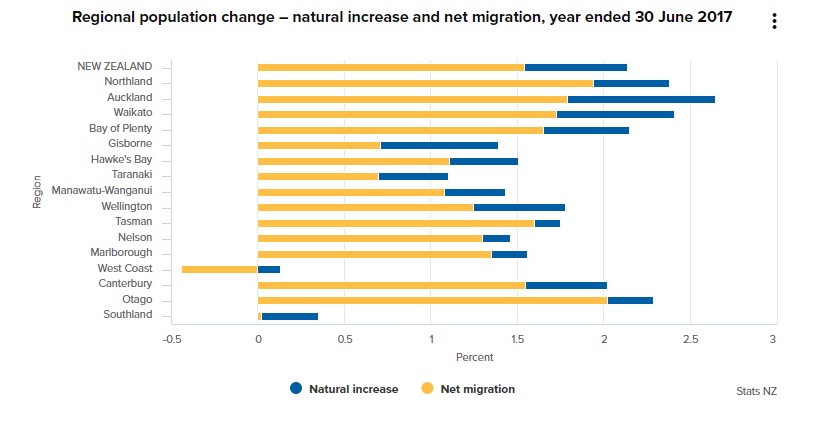
Auckland can either be an expansive city or a expensive city.
For Auckland, its strongly increasing demand for urban space contains the seeds of its destruction, because it has become an expensive city where housing supply only responds inelastically to demand.
This has implications for productivity, academics such as David Schleicher and Alain Bertaud, indicate inelastic housing supply is a significant barrier of entry for a cities labour market. Such as Auckland’s schools are currently experiencing with their teacher recruitment difficulties.
Excessive house price inflation is also contributing to rising inequality.
Piketty has shown that returns on capital is greater than economic growth but further analysis by the likes of Rognilie has shown that this effect is due to property not productive capital.
Auckland’s inelastic housing supply is primarily due to restrictive land-use regulation which stops density and fringe growth and a broken system of infrastructure financing.
Secondary factors would be; a private sector land banking business model, a boom/bust degraded and monopolistic construction industry and a central government which has been largely absent from the provision of urban growth corridors for at least 30 years.
It is possible to derive New Zealand’s new government’s Urban Growth Agenda using a full demand and supply analysis of all the different types of urban spaces. I would refer you to my paper - Successful Cities Understand Spatial Economics to understand the sort of factors which need to be considered.
The government’s Urban Growth Agenda has five broad areas of reform, - infrastructure financing, pro-growth land-use replacing urban growth boundaries, transport pricing, spatial planning and legislative reform.
Examples of what this means would be, RMA National Policy Statements, Urban development authorities, Kiwibuild, disruptive off-site manufacturing, NYU Stern Making Room paradigm used to lay out growth corridors, congestion road pricing, greater government involvement in providing a mass transit congestion free network.
Two important strands to understand is Automobile Dependent Sprawl and the Compact City
For a long time in New Zealand, these two strands were knotted together so tightly the public debate could not move forward.
The difficulty is that both strands have great strengths but also fatal flaws, especially for Auckland.
This means they can’t be ignored but also that neither strand can be a sole solution for urban development in New Zealand.
The flaw of the compact city strand is a lack of focus on competitive land-use provision and good infrastructure financing needed for affordable housing.
The flaw of automobile dependent sprawl being the country cannot afford Auckland’s ever more expensive motorways (also until New Zealand transfers to a full electric vehicle fleet automobile dependent sprawl is not helping the country meet its climate change goals).
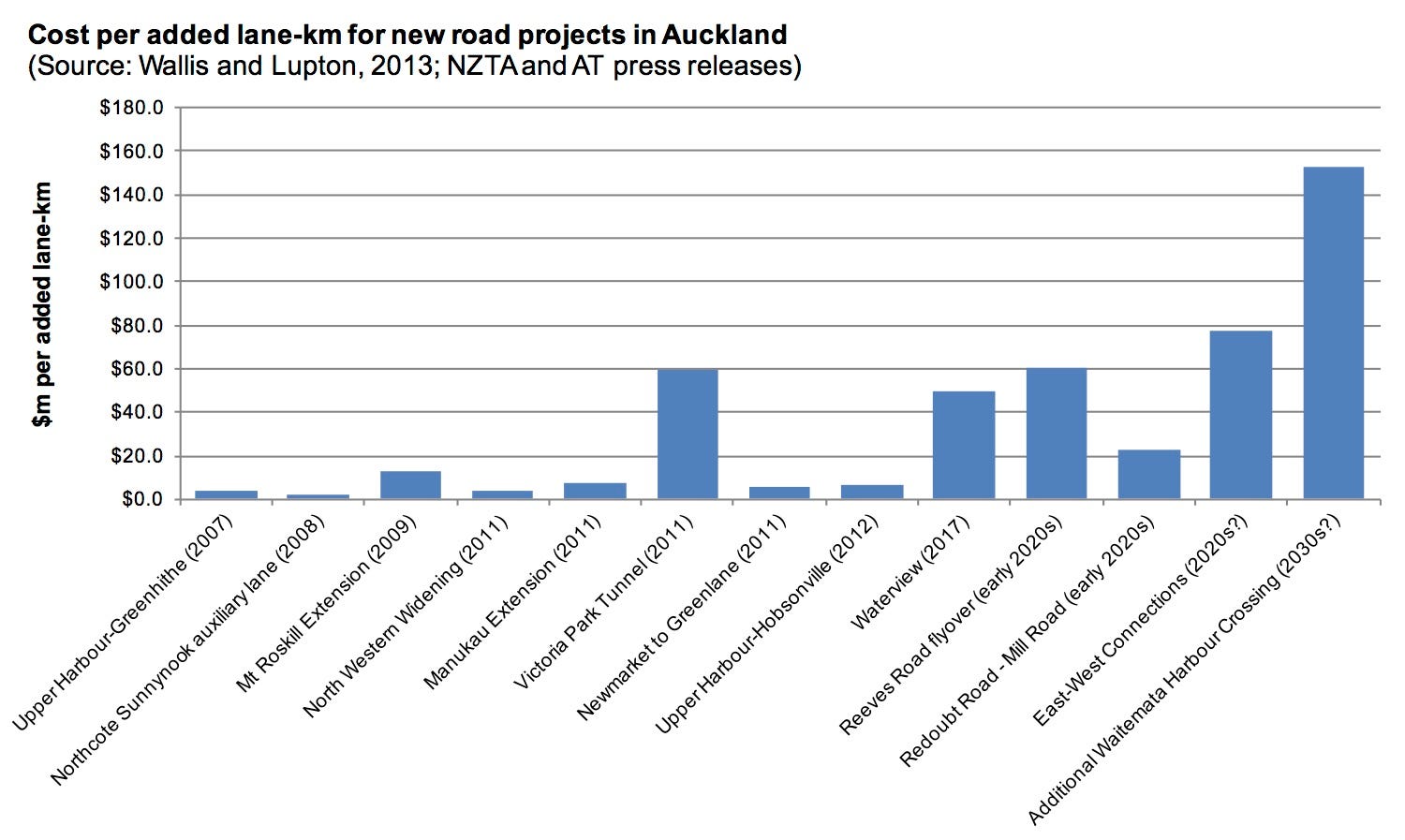
The above cost per added lane-km graph for new road projects clearly shows the increasing costs of motorway provision needed to feed Auckland’s expansion.
This means the urban growth model which Auckland has used since the 1950’s, being expansion provided by automobile dependent sprawl, has reached its limits.
The key solution for containing Auckland’s motorway expansion costs is road pricing. This will provide an economic incentive to transition to more space efficient transport modes, such as Auckland’s proposed congestion free network of rapid transit services.
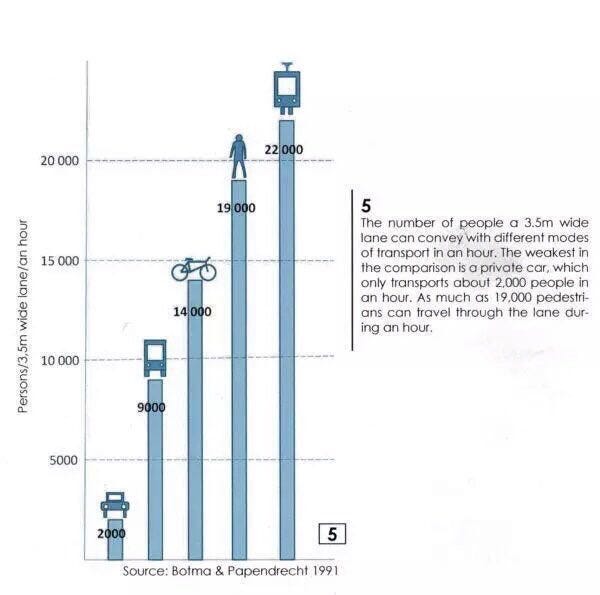
Perhaps, more importantly than a simple transport mode shift, is that in response to congestion road pricing city residents adjust their travelling patterns at all sorts of levels. The Stockholm example indicates this change occured unconsciously i.e residents were not even aware that their behaviour had been affected.
There are many possible ways transport patterns could change. For example some residents might change the time they travel, some might move closer to employment and other important amenities, some car dependent businesses (car yards for example) might move to less congested locations, etc.
The Stockholm experience of congestion pricing is that transport is a complex social pattern that is self ordering like bread production in Western countries.
Stockholm found that congestion pricing became more popular over time, going from a clear majority who opposed the reform prior to implementation, to a clear majority who now favour it.
David Lupton’s paper on road pricing and urban performance - Cities are the Future in my opinion was one of the factors in freeing up the urbanisation debate by acknowledging the strengths of both the compact city and urban sprawl strands whilst avoiding their flaws.
Road pricing has support from across the political spectrum in New Zealand.
This approach unlocks a new vision for an expansive city. An approach that is more organic, less prescriptive, that prices rather than rations or subsidises urban space.
Many aspects of this new vision of an expansive city, compact city types favour -such as, the transition to more spatial efficient transport modes, removing car parking minima and relaxing restrictions on intensification -density, height, setback…
My paper What is the Secret of Tokyo’s Affordable Housing, is a longer description of a framework for an expansive city that compact city types favour.
Rebalancing the continuum between devolution and centralisation
This strand looks at how local government as it is currently arranged creates an insider/outsider problem which will require rebalancing.
Local government represents existing residents, both for electoral reasons and because legislation directs councils to consult their resident communities.
The problem is many local government land-use decisions affect potential future residents. Especially future workers. But these groups interests are not being addressed and as discussed earlier, barriers of entry into the city are created.
The rebalancing can occur in two directions - devolution or centralisation or both.
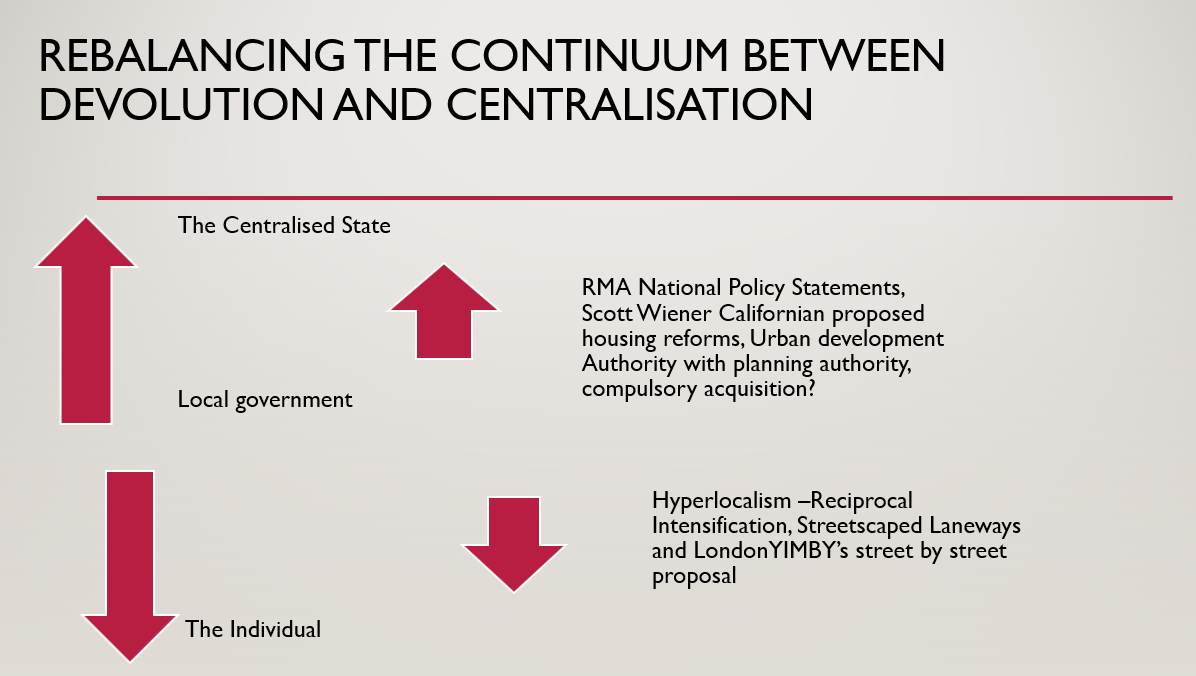
Centralised solutions being the most commonly advocated option.
For example, a higher form of government addresses the needs of those locked out of the city, by relaxing the restrictions on urban growth -such as Scott Wiener’s California proposals to relax building restrictions around city rapid transit lines.
Other centralising ideas would be the creation of an urban development authority with planning permission powers and perhaps even compulsory acquisition powers (if there are holdouts for site assembly).
What is less commonly advocated is hyperlocalism, where planning permission rights is devolved down, almost to the individual level i.e.-a set of neighbours or a street.
I have proposed two hyperlocal ideas - reciprocal intensification and streetscaped laneways.
These ideas have generated some interest, in particular, from the London YIMBY organisation which independently created their own street by street hyperlocal proposal.
In theory, both centralised and more individualised solutions could occur simultaneously.
For example, an Urban Development Authority could encourage groups of neighbours to undertake their own streetscaped laneway development, by giving community talks, providing financial, budgeting, planning and architectural advice.
Fairness is the final strand
As I described earlier in the spatial economics strand, Auckland’s housing crisis increases inequality.
An example of rising inequality in New Zealand is the increasing number of homeless - 41,000 in the 2013 census, nearly one percent of the population is severely housing deprived.
Renting reform in New Zealand historically has not been a priority as it was considered a temporary state for most people. This is no longer the case.
To improve Auckland’s housing inequality problems, reforms will need to provide a minimum health standard of warmth, dryness and ventilation for rental housing, security of tenure contracts, more state housing for the most vulnerable and a housing first philosophy for the homeless should be best practice.
There is much frustration that home ownership, a previously achievable milestone for low and middle-income earners, has become unattainable in Auckland.
There is a fear this loss of social mobility will mean Auckland’s society fractures into generation rent serfs and landed gentry masters.
Losing the kiwi dream of a fair go society would be a big risk for creating political instability.
Globally angst against elites has translated to increasing popularity of populists -Trump, Brexit….

Historically, gradual reform has been an antidote against revolution.
In the 19th century the UK enacted laws on electoral reform (1830s - abolishing the rotten boroughs) and free trade (1840’s - abolishing the Corn Laws), this helped prevent the UK being swept up in the European 1850’s revolutions.
Internationally, housing and urban development reforms have not always been successfully implemented though.
In the US, Mitt Romney’s father George was Nixon’s Housing and Urban Development Secretary.
George Romney considered that the then race riots had a root in the federal practice of ‘redlining’ coloured neighbourhoods so that they did not qualify for federal insured loans.
This sort of institutional racism in housing was pervasive in the US by both the public and private sector. Richard Rothstein documents the forgotten history of how the US government segregated America in a book titled The Color of Law.
George Romney’s Housing and Urban Development department attempted to provide a remedy by instigating an Open Communities Plan of allowing the building of multi-family dwellings in single family housing suburbs in 1970.
This plan would have benefited low income earners and the black communities who were being excluded by zoning from accessing affordable housing near places of employment or economic activity.
Because the development of this plan was siloed to Romney’s department and due to personal conflict between Nixon and Romney this plan was never enacted.
In New Zealand, falling home ownership has impacted Maori and Pacifica particularly severely and hopefully they would be major beneficiaries of successful urbanisation reforms.
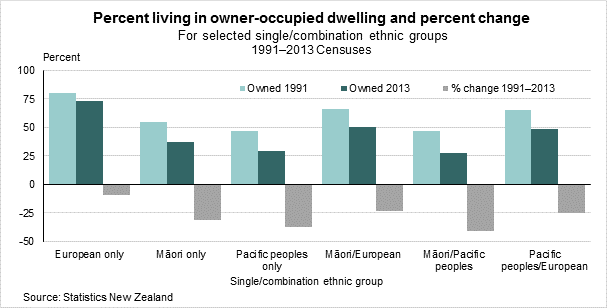
I believe that New Zealand can follow through with needed urban performance reforms. The advantage New Zealand has is the public perceive the housing crisis to be unfair.
The media coverage of Auckland families sleeping in cars turned the housing crisis into a moral imperative and my study of the likes of the Corn Law movement, indicates this moral imperative is a critical factor for ensuring the political will to implement progressive change.
The ‘why’ of improving urban performance is as important as the ‘what’s’.
In conclusion
Understanding the various strands of the urbanisation debate illustrates there are many reforms that New Zealand could and should pursue to improve its urban performance.
Creating a successful urbanisation framework for Auckland would have modelling benefits for other cities, both in New Zealand and overseas.
Gradual and effective urbanisation reforms can provide an antidote to reduce the global risk of spreading populist revolutions.
This is a repost of an article here. It is used with permission.
53 Comments
Brendon: your article could be a book or even a series of books. Not so much 'food for thought' as a mega feast.
"the forgotten history of how the US government segregated America" - it is worthwhile mentioning the US government was the main force desegregating America too. Compare with the UK: where I lived in Spitalfields about 90% of housing was 'council housing' and it was about 90% Bengali (96% of local school children were Bengali). Therefore the local council flip flopping from party to party became (quite justly) Bengali. However the council has now put locals as priority for social housing not social need which was how the poor large family Bengali immigrants achieved their housing in the first place. They had displaced a mainly Jewish community who where reluctantly forced to move out because they had climbed out of poverty. So an example of segregation chosen by a specific ethnic culture. However most of UK is fairly well mixed compared to France and Belgium. The fact that immigrants like to live together in the biggest cities was identified by sociologists 100 years ago. The same forces can be seen operating in Auckland however far milder in effect probably because of the mix of ethnicities and the comparative wealth of many immigrants. We are fortunate to have more social cohesion than most big American and European cities.
Thanks Lapun, luckily Interest.co.nz published my article on a weekend where people have the time to consume a 'mega feast'.
Some of my French Hugenout ancestors lived in Spitalfields before the Bengalis or the Jewish waves of migration into the area.
The Hugenout history is fascinating and well documented, in part because they had a welfare system for new refugees from Catholic oppression in France and some abused it. When someone applied for help, they had to recount their family history to refugees from the areas they claimed to have lived in and they gave the story the once over. Frauds were quickly uncovered.
That sounds fascinating -do you have any links?
It's interesting that as you say, at one time, government was the main force desegregating the USA. And yet as Glaeser and Vigdor point out in their paper a few years ago, "The End of the Segregated Century", the lowest rates of segregation in the USA correlate to high-growth affordable-housing cities, Houston and Dallas being the top examples. This is ironic given the history of explicit racism in Texas and the South; and even more ironically it is the posturing, feel-good "liberal" coastal States that have the worst problem with segregation and "exclusion".
Being an "expensive" city correlates with the population being far more strongly spatially sorted "by income level", and in so far as there are income-level disparities correlating to race, this will parlay into worse racial segregation. Thomas Sowell calls this "Green Disparate Impact", seeing that it is environmental regulations and "save the planet" that is responsible.
There was a shameful time, referred to by Brendon, where the new suburbs all over the US explicitly excluded people of colour, but obviously the affordable sprawling new suburbs in Southern US cities are accepting all comers. Unaffordable prices of all kinds of housing (and "social housing" as the only "solution") are causing, in the so-called "liberal" coastal States, unintended negative consequences for the goal of "desegregation".
Nicole Garnett, Law Professor, sums this up in a beautiful phrase in one of her papers: "There is something unseemly about curtailing suburban expansion just at the point in history where previously-excluded minorities were becoming the principal beneficiaries of the process". It is almost as if the feel-good "liberal" elites never really meant it about segregation.
A contact of mine in the US, Thomas Heller, who worked on urban zoning policy for several politicians during his career, relates a story from a few decades ago where various interests were discussing at a meeting, how "large lot size" (anti density) zoning was becoming less and less effective at excluding "the riff-raff" because the price of land kept falling in real terms, and it didn't take long for structure values to depreciate, and suburbs were one by one becoming affordable to lower and lower socio-economic groups. Heller says he idly commented that "putting a boundary on growth and rationing the land supply" might turn the land prices around and make them inflate rather than deflate, and he says the room was filled with "ahas" and eyes lighting up.
Phil I have read the book "The Color of Law" and it is no exaggeration that the saying that "one should not underestimate the effect of racism in the US" is true.
I am fairly sure that is a comment you have made Phil many times over the years to explain zoning and schooling decisions being a response to the white population wanting to exclude the black population. Richard Rothstein's scholarly work/book certainly proved that for me.
I followed the link to 'the color of law' and it seems to relate to the 1930's. Not a good time when black and white jazz musicians couldn't play together in public. But the racism of the 30's shouldn't be held against the USA of today even if it is still reflected in distribution of wealth related to owning property in wealth suburbs.
Before condemning the USA compare with Catholic -v- Protestant villages in NZ and our barriers to Asian migrants however talented and read the literature of that period with its casual racism. It took the holocaust to make us scared to be labelled racist. Even then for a couple of decades we could still condemn homosexuals and of course women were clearly 2nd class (division of property on divorce, etc).
Lapun the period where the Federal government of US was engaging in racist segregating housing policies was from the 1930s to 1968.
Efforts made in the past 50 years to find affordable housing remedies from the US Federal government have come to nought. Despite having at times a committed and active Housing and Urban Development spokesman.
This US example is a cautionary tale for NZ that successful housing reforms can be difficult to implement.
Especially the highest levels of government in the US have struggled to implement effective housing reforms.
The U.S. as Phil Hayward describes has had more success in implementing affordable housing policies at lower levels of government. Some States and cities having much lower barriers of entry to their markets due to their liberal zoning and infrastructure financing policies.
Not denying that the USA when I lived there had ethnic groups living in separate suburbs. And the same occurs in my son's country France and in my country of origin UK and I suspect areas of South Auckland where 90% of the kids at a college are Pacifica. It seems tough to say the USA in 1968 had a government that was racist given the considerable efforts made by President Lyndon Johnson's administration to pass civil-rights bills that banned racial discrimination in public facilities, interstate commerce, the workplace, and housing and he also removed barriers to immigration from non-European countries. Compare that positive behaviour to the inaction by my then UK government about civil rights in Northern Ireland. That led to an unnecessary smouldering civil war that cost the UK billions and destroyed many innocent lives.
In 1968 one week after the assassination of Martin Luther King, the US passed the Fair Housing Act which stopped discrimination from federal authorities, it meant black neighbourhoods could get access to cheaper federal backed mortgages etc.
https://en.m.wikipedia.org/wiki/Fair_Housing_Act
So you will rewrite ""one should not underestimate the effect of racism in the US"" adding pre-1968 (50 years ago). All countries have racism (along with the other deadly sins: pride, greed, lust, envy, gluttony, wrath and sloth) but at least the USA is willing to try and tackle their problems. Why not include info about the suburbs of Paris, Brussels and London today rather than rake over the olden times in the USA.
Actually a lot of good things in housing does happen in the US and overall, except for the minority of States like California they are better off than NZ, Australia and the UK.
The point I was trying to make was about George Romney who was a well intentioned Housing and Urban Development minister from 1968 to 1972 much like our Phil Twyford is now. But George Romney was not able to overcome the then political/economic difficulties to enact his housing reforms of allowing affordable multifamily dwellings into single family dwelling suburbia.
I think or at least hope there is more political goodwill in NZ (compared to the US 50 years ago) so that Phil Twyford's housing reforms can be successful.
Lapun-Bob Atkinson
Can I suggest you research the history of the Maori insofar as the central role of the Marae as the heart of the tribe or sub-tribe and how that fits into their essence, which develops their age-old embrace of the "wider family" practices and responsibilities which in turn devolves into a "lack of acquisitiveness" or the lack of need for materiality and need of a singular essence which is provided by the marae - it is not too much of a stretch to conclude these characteristics and behaviours manifest themselves negatively compared to the Asian obsession with land acquisition
Our immigration policies are detrimental to the Maori in both the short term and the long-run
I'm very reluctant to say anything about Maori; the first two Maori I met were both great family men, great sportsmen, very pleasant and both higher ranked at the firm where we worked together. Now both are multi-millionaires. So coming to NZ and discovering the pakeha prejudice was the opposite of my own bias has been interesting.
Having a Pacifica family does remind me of the importance of family, place and religion which the British had maybe 60 years ago but have since lost.
Our current immigration policies are certainly doing most Maori no favours but can hardly be compared to the effect of my ancestors immigration starting 200 years ago. It would have been better if Captain Cook and his followers had brought writing, money, new food stuffs, schools and medicine and then in the main returned home; more like Malaya.
For a characteristically well written Maori view on immigration read Ranginui Walker's http://www.thesocialcontract.com/artman2/publish/tsc0402/article_316.sh…
Lies, damn lies and statistics. Your final graph based on census data 1991 & 2013; my European/PI family arrived in the middle of that period. How many equivalent families existed in '91 compared to now? What was their average age? How far can you trust self-reported ethnicity?
I do think your conclusion is correct: " falling home ownership has impacted Maori and Pacifica particularly severely" but relates to both relative poverty and also motivation. Some Asians seem to have an almost fanatical desire for a standalone freehold house (historically understandable too).
Lapun I think Stats NZ (from the census) measure of percentage who own their own home from the groups who identify themselves as the various ethnicities is significant. It indicates I think that access to affordable housing has become significantly tougher for those particular groups.
Of course NZ does not have the same racial tensions as the US. We have a different history and despite our problems I believe there is more goodwill between the races here in NZ.
Lapun makes an interesting point about Asians. It is the same story in the USA; they are above-average success stories in spite of racism and in fact they are discriminated against by "affirmative action" policies with racial quotas, because Asians would be over-represented by way of their own efforts if the quotas were not barring them. But you don't see them resorting to civil disruption over it.
I was tempted to add with no data to support it that PI's with money send it their home village or give it to the church or just have fun spending it. Asian (if you permit this very large disparate category) will loan funds to help family buy property. A pakeha like myself is not greatly bothered about owning or renting but Asians have a different history with peasants owning land having a different status to peasants renting the land they work. So historical motivation may be as significant as wealth differentials.
Apologies for a dreadful generalisation, just may contain a grain of truth.
Comparing percentages without numbers is rather misleading.
The emphasis should be on home ownership and income at a given age.
That graph is for NZ but we know immigrants tend to live in Auckland where house prices are far higher; the arguments about how a city develops can be made without bringing ethnicity into it.
Given the crazy Auckland house price inflation inequality must be increasing and that is not good for NZ (both poor and rich).
I thought the description of the end of automobile dependent sprawl for Auckland would have triggered some debate. But of course matters of race beats all other issues.....
Apologies Brendon. Just my hobby horse. I was meaning to write about congestion charges. Another hobby horse admittedly. You made a good point about them being unpopular; I have been in favour of them for a long while and forget how most Aucklanders think. To most drivers a congestion charge is 'a new tax'. They don't seem so worried about excise duties which just keep going up nor an Auckland regional fuel tax which is likely to result in inefficiencies around the edges of Auckland.
The problem with a congestion charge is the admin costs; for the Puhoi tunnel they are reportedly very high. If they can get the costs down (which I am sure they can) then it really makes sense. On other blog sites I've pushed the need for a core software module developed by the government that ties together the billing with vehicle Regos and a secure online access. This could handle speeding and other vehicle offenses. So as a car owner I could log in and see what I owe and why and if I commit an offense an optional email arrives informing me (a bugbear with the current system is a letter arrives two weeks after the event and then the family discusses who was driving what car). Renewal of rego requiring payment of outstanding charges (fines, congestion, etc).
Giveen this base module then the arguments about what form the congestion charge takes can be resolved on a city by city basis and changed in real time (ref the development of the TradeMe site - they can alter it in the morning to make it more user friendly and decide it is delaying users on average so change in back in the afternoon - that is how software ought to be).
A defense of congestion charging: my family live north of Auckland and travel north to work in Albany; been doing so for a decade. It used to be easy because most drivers are heading into Auckland CBD. Now the number of vehicles trying to head south have made the journey north a nightmare with road junctions blocked by cars queuing to get on the motorway. My family are driving much farther, much slower and are leaving home at 7am but they are not actually contributing to the congestion since it is still a small minority that travel north. An intelligent congestion charge would attempt to dissuade use of vehicles travelling south on SH1 from the north in the morning. Increase congestion charge and reduce bus prices and increase parking for the buses.
A way of persuading drivers to stagger their journeys would be to charge differently by time of day even to the point of giving a refund to those travelling out of peak time - obviously it would have to be sufficiently small an amount to prevent users driving to make money but it might help with persuading drivers of the benefits of sensible congestion charging.
The technology for real time variable road charging should be doable -to achieve the things you want Lapun. Whether that is digital recognition of car registration or a GPS type system or something else. Uber essentially already do it for their vehicles. So it should be possible to do with low transaction costs.
Of course it is doable. The Puhoi tunnel uses car registration recognition. Put that at every motorway entrance and then the police could have caught the youngsters who stole my car and drove it to Takanini.
It is aggravating the way they can't see the opportunity. They are waiting for someone else to develop something and then buy it but without interface to a government central database it will never be much use.
Compartmentalisation
7 years ago my son was installing CCTV cameras on telegraph poles at all the traffic lights along Broadway in Newmarket - that was for whoever controlled the phasing of the traffic lights - presumably not accessible by the police - not their department - policing is a central govt responsibility - the CCTV was for the Auckland City Council which is local - the infrastructure was there 7 years ago - then he was off doing similar things for the Wellington City Council
I usually hate the government taking authority from local governments but this is one (enforced standards for pollution is another).
Chris Lynch had an excellent interview of Phil Twyford which covered all the different strands of the urbanisation debate. What was most interesting is Phil gave an indication of his order of untangling. Being that infrastructure financing needs to be tackled first. The audio is here and the most interesting part is from the 11min mark
http://www.newstalkzb.co.nz/on-air/christchurch/canterbury-mornings/aud…
Brendon: have you considered nationalising all land. This is drastic but effectively similar to Singapore. It would reduce the price of my own house by 75% according to the CV so I'd no longer be a millionaire but at least my kids could buy.
Kiwis seem to have an aversion to leasehold land and i suspect any government that attempts to nationalise the entire countries stock of private property would not be in government for long.
When home ownerships drops further the dispossessed will rise up and vote communist. It's happening in SA.
Land not the property on it.
If the Government nationalised all land, it would effectively declare the populace to be serfs. I can start to see why the right to bear arms is so deep seated in US psyche.
How do you figure that, it would be owned by everyone.
Problem is not the ownership by the many. It is the fact that the central committee will adjudicate what the land will be used for based on the politburo 5 year plan.
The many may "own" the land, it's usage but is controlled by the 1% in charge of the socilaist/communist regime.
Exactly and people wonder why Chinese are so keen to own a piece of land that isn’t nationalised.
But in our utopia you can do what you want so long as you have council arborist approval, geotech report approved by council, survey to the nearest millimetre whether you need it or not required by the council, stormwater run off approved by the council, connection to the sewers done by contractors with council approval and of course a planning consent. Noise control too.
It is incredibly ironic that Singapore is regarded by some as libertarian free-market utopia and yet the government owns all land. They still have a property market and "ownership" of property but it is the structures, the land is leasehold. It does get round the problem of land price inflation and capture of value by private sector rentier-capitalists.
I think in Singapore it is a case of extreme pragmatism; if they had normal amounts of space for a sovereign nation, they probably would not have resorted to this system, they would probably have had affordable sprawl like much of the rest of the first world. Or maybe they would have had the excellent Japanese system where there are multiple mass transit enterprises who also own all the property serviced by their routes, and compete with each other for tenants as well as riders.
I love the way the Singapore civil service is structured, it is another example of real-world pragmatism. Personnel are rotated in and out of it so they have private sector experience and know how the real world works, and they aren't there long enough for the system to suffer from the "bureaucratic empire building" effect. They are paid well while they are there but are "let go" as early as possible if they are non-performers. Contrast this with the civil service pretty much everywhere else.
""George Romney considered that the then race riots had a root in the federal practice of ‘redlining’ coloured neighbourhoods so that they did not qualify for federal insured loans."" No need to go so far back - my sister used to live in Huddersfield Yorkshire on a long road into the city. At the bottom end of the road the properties descending into slums and mortgages and insurance both became problematic - neither controlled by the government.
Even Hobson St Auckland contains apartments of under 40sm built in this century that banks will not give mortgages. Do you think the government should force banks to remove their arbitrary limits? An apartment of say 28sm can be quite suitable for some people - let them have a choice?
And the last I heard the UP was enforcing 40sm minimum builds.
""Urban Development Authority could encourage groups of neighbours to undertake their own streetscaped laneway development, by giving community talks, providing financial, budgeting, planning and architectural advice."" sounds like a dream. Auckland central planners do everything they can to stop development or at least development by individuals of average wealth.
How about a 40m high pine tree on council land that overhangs my property where someone more energetic than me might want to build a couple of terraced houses. The council arborist said it would need a helicopter to remove it despite my assuring him it could simply fall in my garden and I would arrange for it to be cut up and taken away. So hearing all about geotech reports and surveys and development contributions I've just let that land return to bush - too big to garden.
It is a dream that the council might actually come and discuss with me and my neighbours how to develop our street.
That should not be a dream Lapun. Building human shelter is a natural need that we have made waaay too complicated
Well I gave up before I started. When my wife and I die the property is most likely to be bought by a developer. Costs would be upwards of $200,000 just to get to the point of hiring an architect and then their would be all the noise and dust and building costs before any hope of getting the investment back - and who knows what the housing market will be like in three or four years?
Have we got the financing the wrong way round? The govt or council ought to be paying the developers costs at each stage and then getting them back when the property is approved for habitation.
Brendon: Your article has a single reference to Kiwibuild. Don't you think it is a potential game changer?
KiwiBuild has been most useful at focusing the government's attention on how to improve urbanisation. KiwiBuild will not work if land supply and infrastructure funding is not fixed. And in Auckland the government cannot afford to continue building ever more motorways through the narrow and expensive geography of Auckland. So KiwiBuild has been a trigger for a lot of thinking about improving urban performance.
In of itself, Kiwibuild will do good things for the construction industry, it will give the industry confidence to make long-term investments in productivity -such as apprentice training and prefabrication. Done right it will also expand competition in building supplies away from its current duopoly state.
KiwiBuild will also demonstrate to the market different types of housing that is unfamiliar to NZ's predominantly monoculture of stand alone suburban housing.
Pardon a dumb question but how is urban performance measured? Happiness or wealth produced and if the latter who gets to keep the wealth?
I'm asking because Len Brown was so keen on the worlds most liveable city. He did not define liveable but when I asked him he was very keen to put everything in the centre - offices, students, arts, tourists, pubs claiming 'all the worlds great cities have a great centre' which is both debatable and still doesn't define 'great' other than looking good on photos of the scale models of exciting new projects.
In the last 15 years Auckland CBD has become harder to get to and employs more low paid workers travelling ever further and ever slower to get to work.
Lapun that is a good question (not dumb) and unfortunately I don't have a definitive answer. I think these changes would be politically popular which probably represents a move towards a pareto optimum outcome.
The article and title came from a presentation I did for a job interview where the question was on 'how the government could lift the performance of Auckland as a city'. I widen the focus to improving urban performance for all of NZ for this article.
Had to look up 'a pareto optimum'. I suppose we can leave it as 'we will know it when we see it' so long as we don't trust the mayor's opinion.
Given that title I would assume they meant economic productivity. But with reasonable constraints about introducing slavery and mercy killing all who are too old to work. I remain surprised that the agglomeration effect doesn't leave Auckland considerably wealthier than it is. Maybe all the smart money is in property not actually running businesses that make things.
Policies that effectively freeze property prices would help. And an excess of your knock down the standalone and build apartments will not help - not a bad idea done in reasonable consistent volumes but a repeat of the boom and bust of apartment buildings about 15 years ago has to be avoided.
Good article Brendon.
I'd add to it and say that there should be no covenants on new development and all existing covenants should be sunsetted in 10 years.
What is the issue with covenants? The only one I've come across (my ignorance) is an apartment block that prevents owners or tenants putting their washing out on the balcony. Is that an example of a covenant?
Yes it is -but of the relatively harmless variety -it is just an attempt to manage 'nuisance' between neighbours. Developers of greenfield sites though use covenants to increase land values (as they drip feed sections onto the market at increasing prices). They do things like prevent smaller houses and multi-dwelling houses being built -covenants like this is another type of restriction which prevents affordable housing coming onto the market.
I have another example - there is a suburb in Albany where the posh houses have a covenant not to use corrugated iron on the roof. Maybe all covenants should require Council approval so restrictions are rational; for example restrictions about property sizes should have a time limit.
""Urban planning always fails. They can't predict the future. So instead of predicting it, they try to envision it and they envision a past that they understand. Then they try to impose that on the future by passing all kinds of regulations and all kinds of laws.""
https://www.stuff.co.nz/national/102928780/as-government-signals-big-li…
Brendon,
Good article, however factually wrong on one important aspect. The urban growth model which Auckland used since the 1950’s, expansion provided by automobile dependent sprawl, was ditched in 2010 for a new growth model. We are now a Super City which uses (the worst) aspects of both expansive and compact development. Auckland is uniquely an expansive city AND expensive city.
Auckland Council now rapidly expands land supply to Auckland Region, almost doubling land supply under the new planning regime. The amount of sprawl being created is phenomenal, a city of a mere 1.6 million is spreading its RUL over 100 km across. This expansive council rule is not governed by automotive constraints, the Auckland model now initiates expansion well beyond anything previously tried.
Auckland City is now a compact city. The land supply to Auckland City has been cut to way below normal requirements. Which as you observe makes the land supply very expensive and building of intensity has slowed to a crawl.
Both of these aspects impose high costs and therefore the remedy is to find a way to reduce costs. Congestion charging is a way of reducing demand, but the problem is mostly not demand. The solution is to halve the total amount of sprawl, but move the land supply closer to Auckland City.
Thanks and I think there is something in what you say about Auckland being both an expansive and an expensive city.
There could well be a leap frog effect over the UGB to the next satellite town or lifecycle block area for house builders in the Auckland region.
This effect is certainly noticeable in Greater Christchurch, which I am more familiar with.
This is not leap frog development.
The land in the satellite towns is planned release financed and controlled by Auckland Council (it is officially inside the Auckland RUB). Developers are not skipping over the land proximate to Auckland. Developers are building on the closest available land to Auckland.
Auckland Council creates sprawl much faster than feasible by design.
Your solution sounds good until I remember how it was done in the UK: sell off school playing fields and build on public parks. Basically if it was green concrete it over and build maybe leaving a couple of small trees between the tower blocks. It is only a generation later they realise you can have both public green space and high density low profile terraced housing.
We welcome your comments below. If you are not already registered, please register to comment.
Remember we welcome robust, respectful and insightful debate. We don't welcome abusive or defamatory comments and will de-register those repeatedly making such comments. Our current comment policy is here.